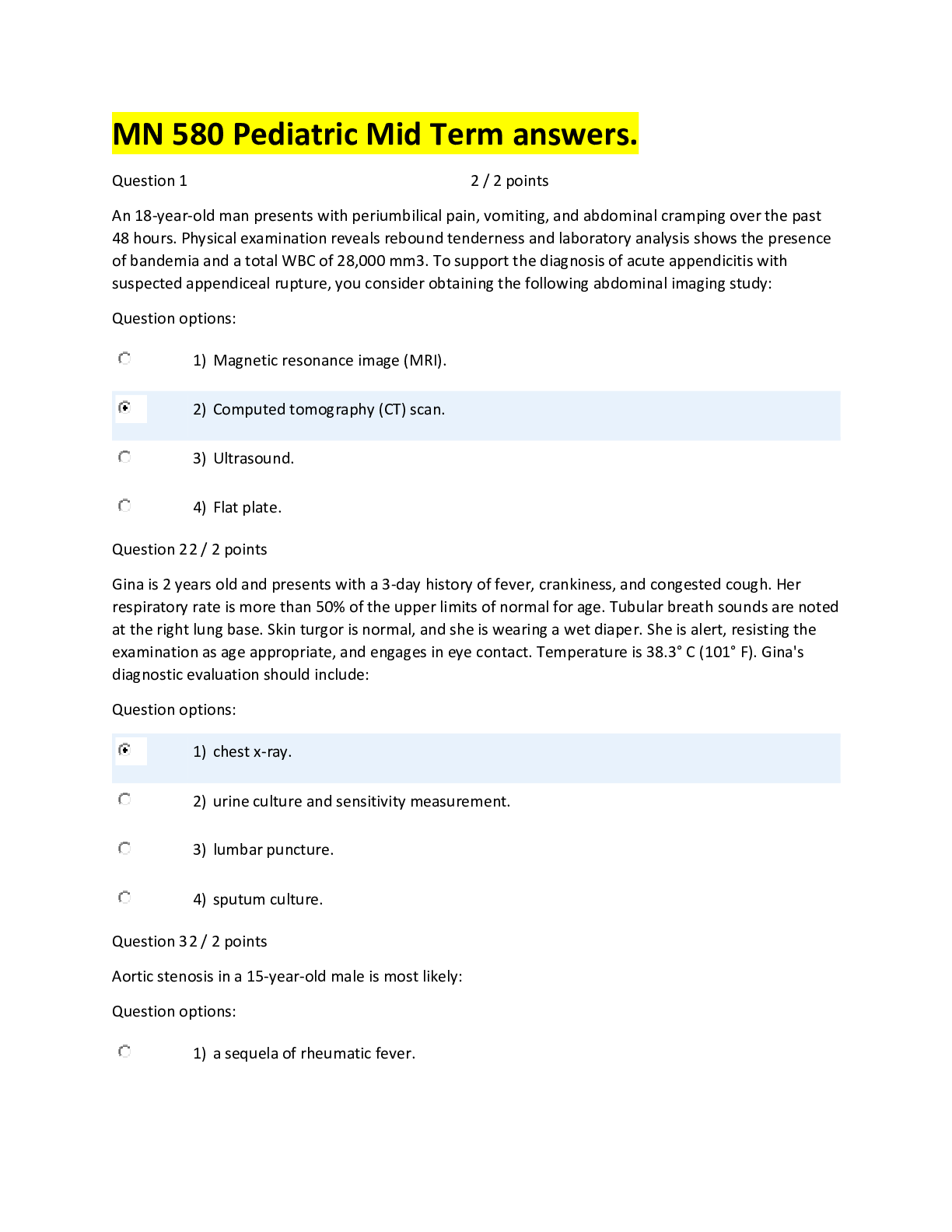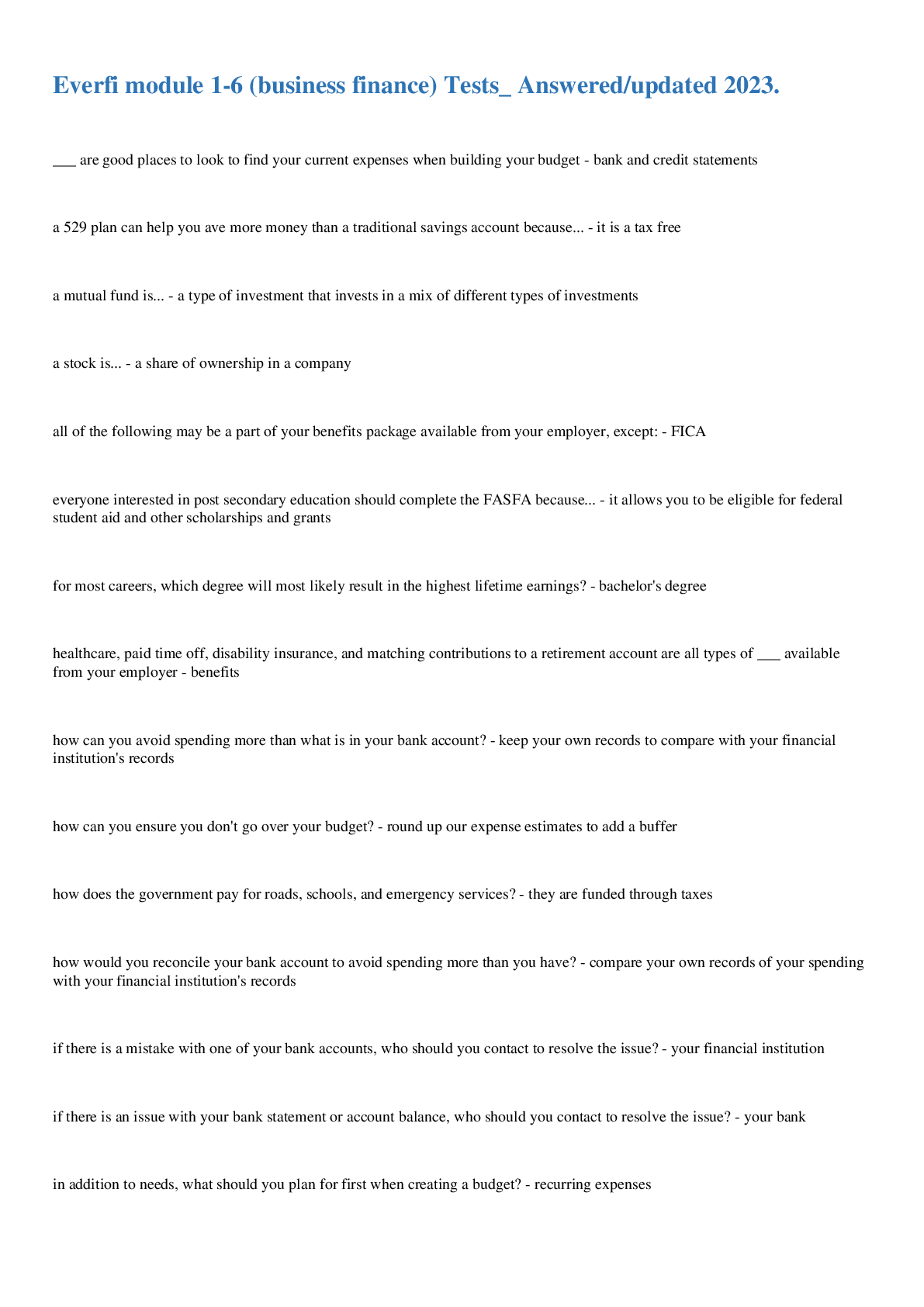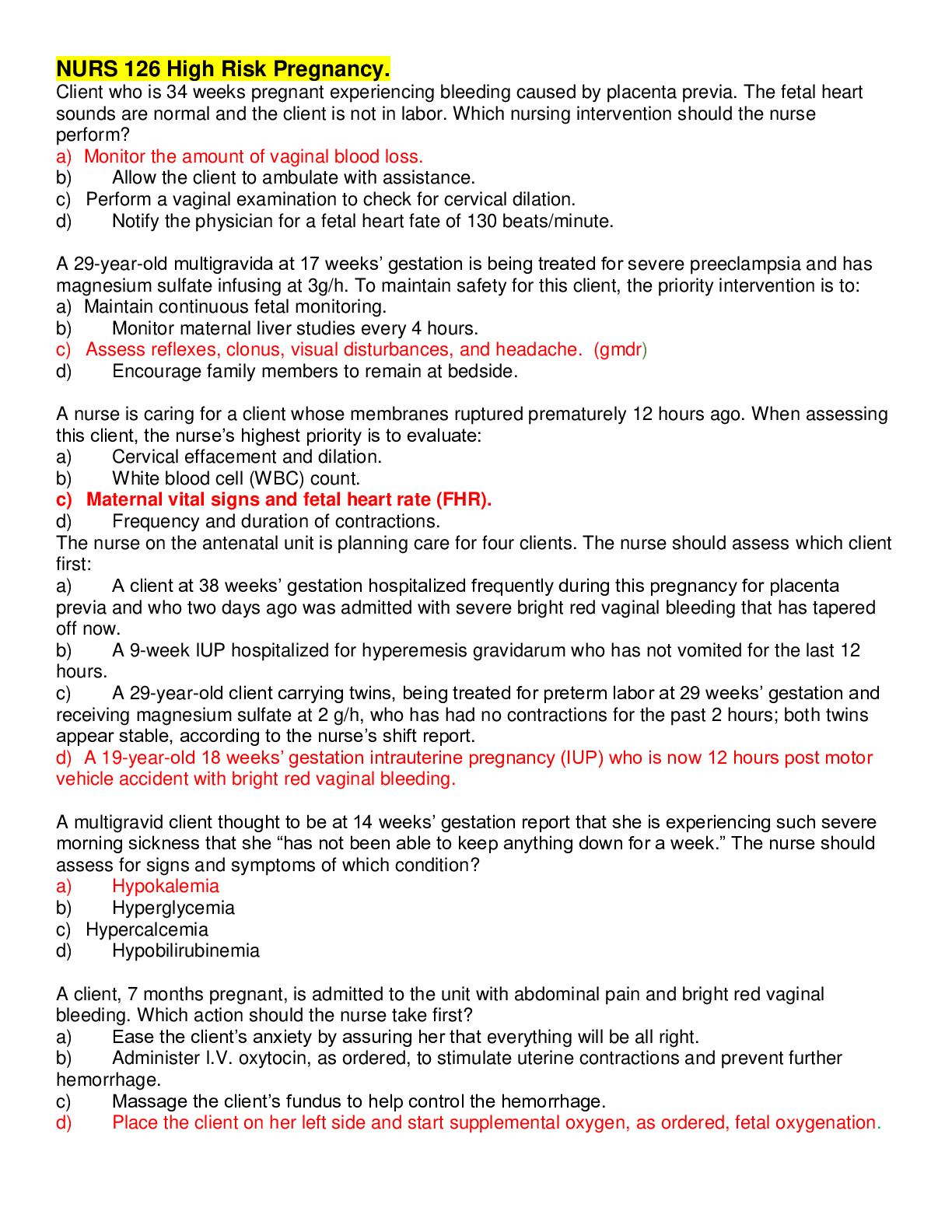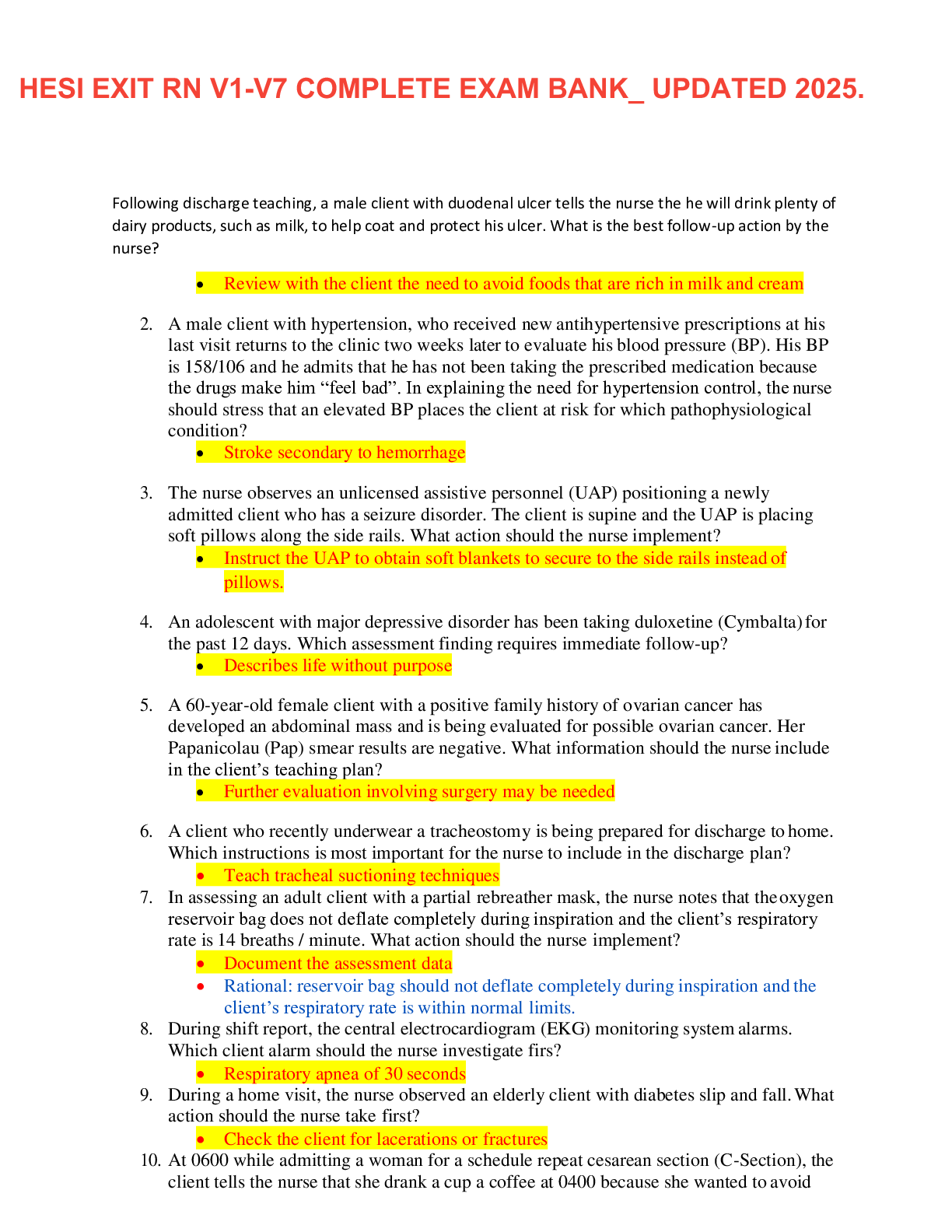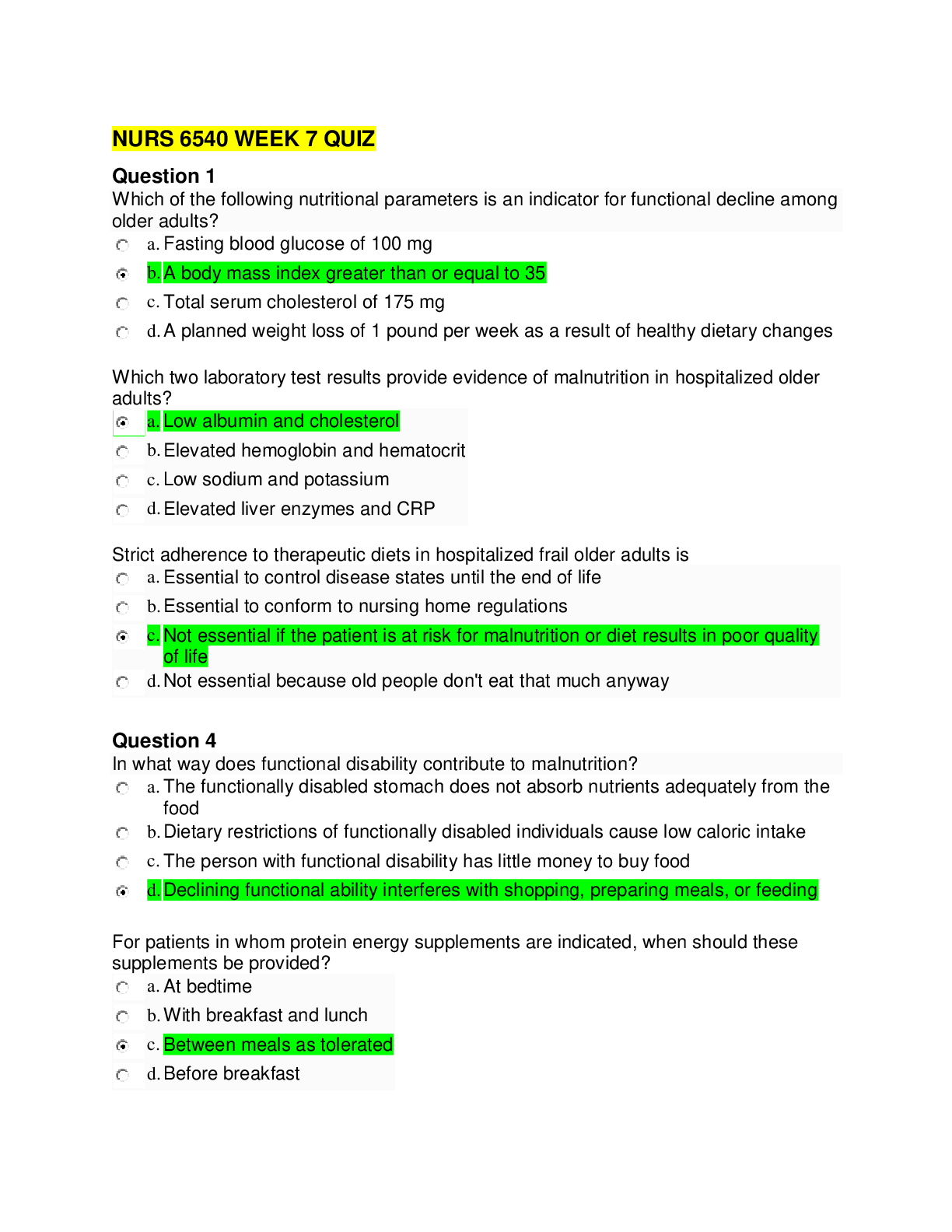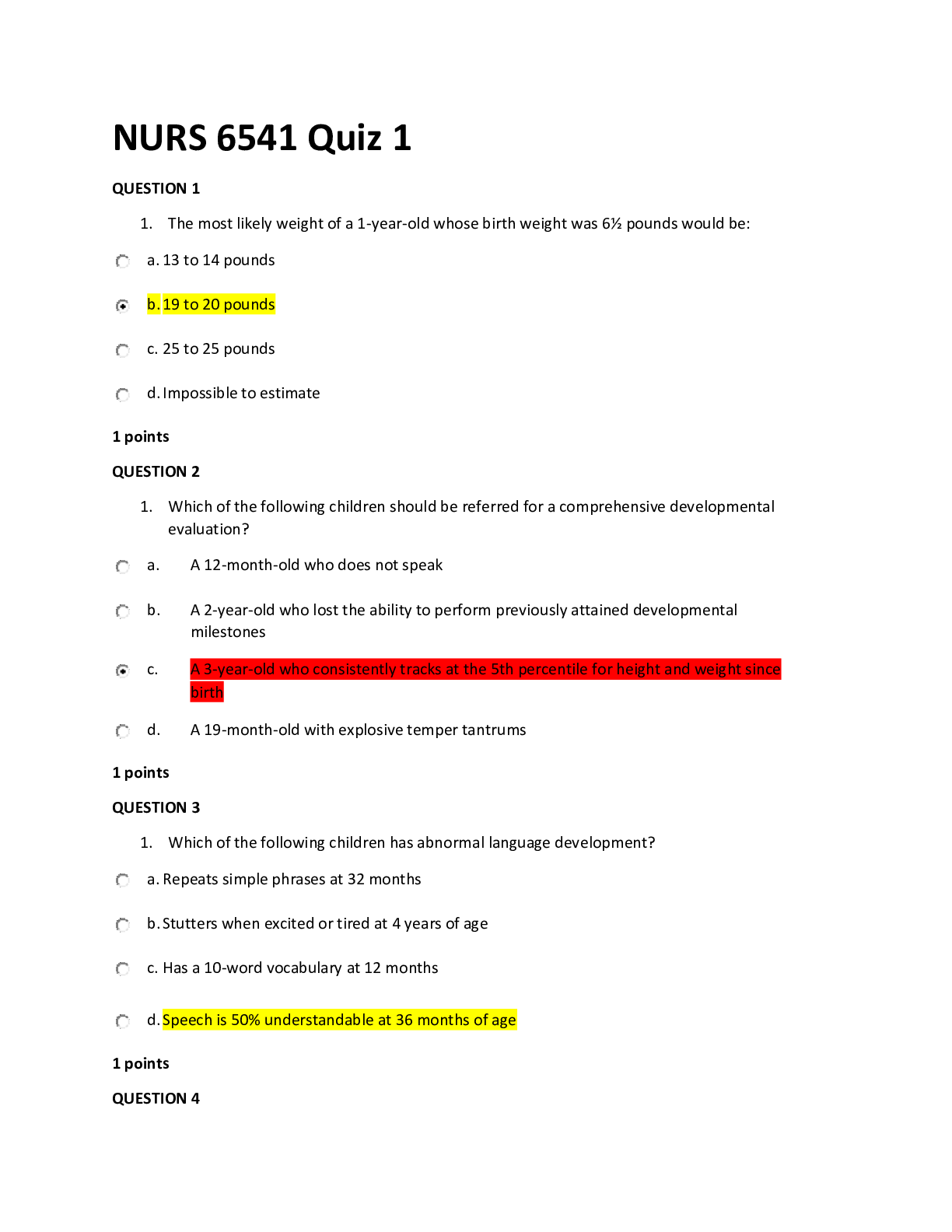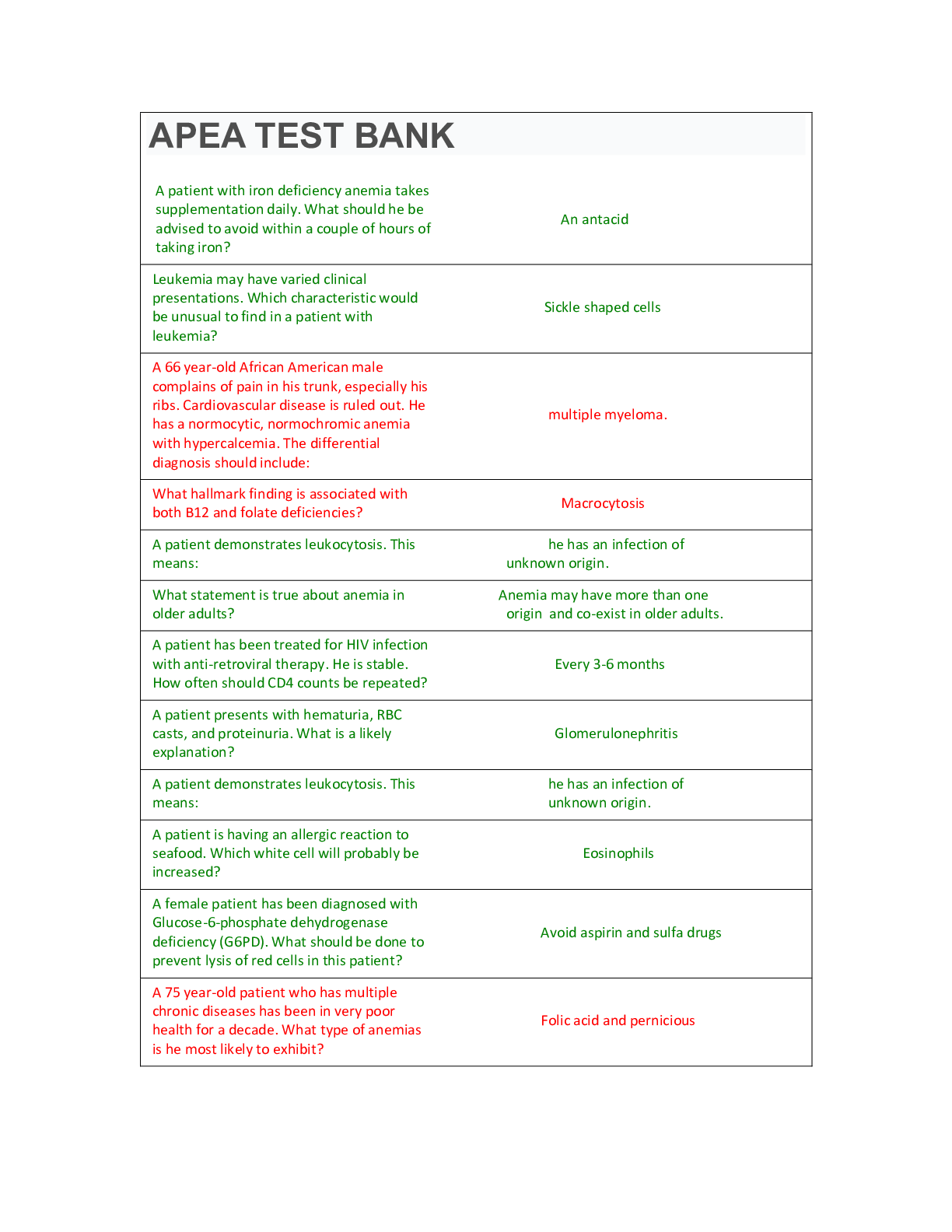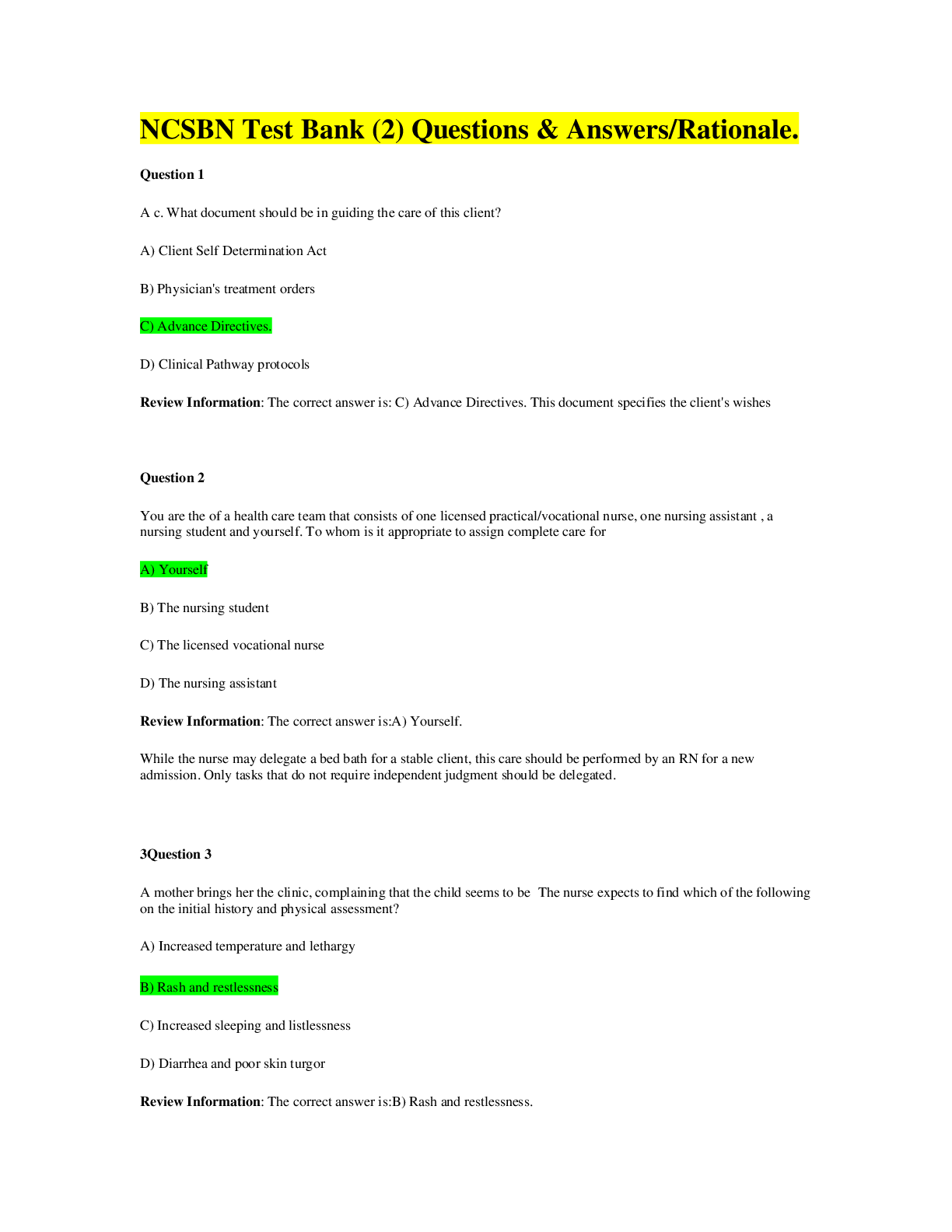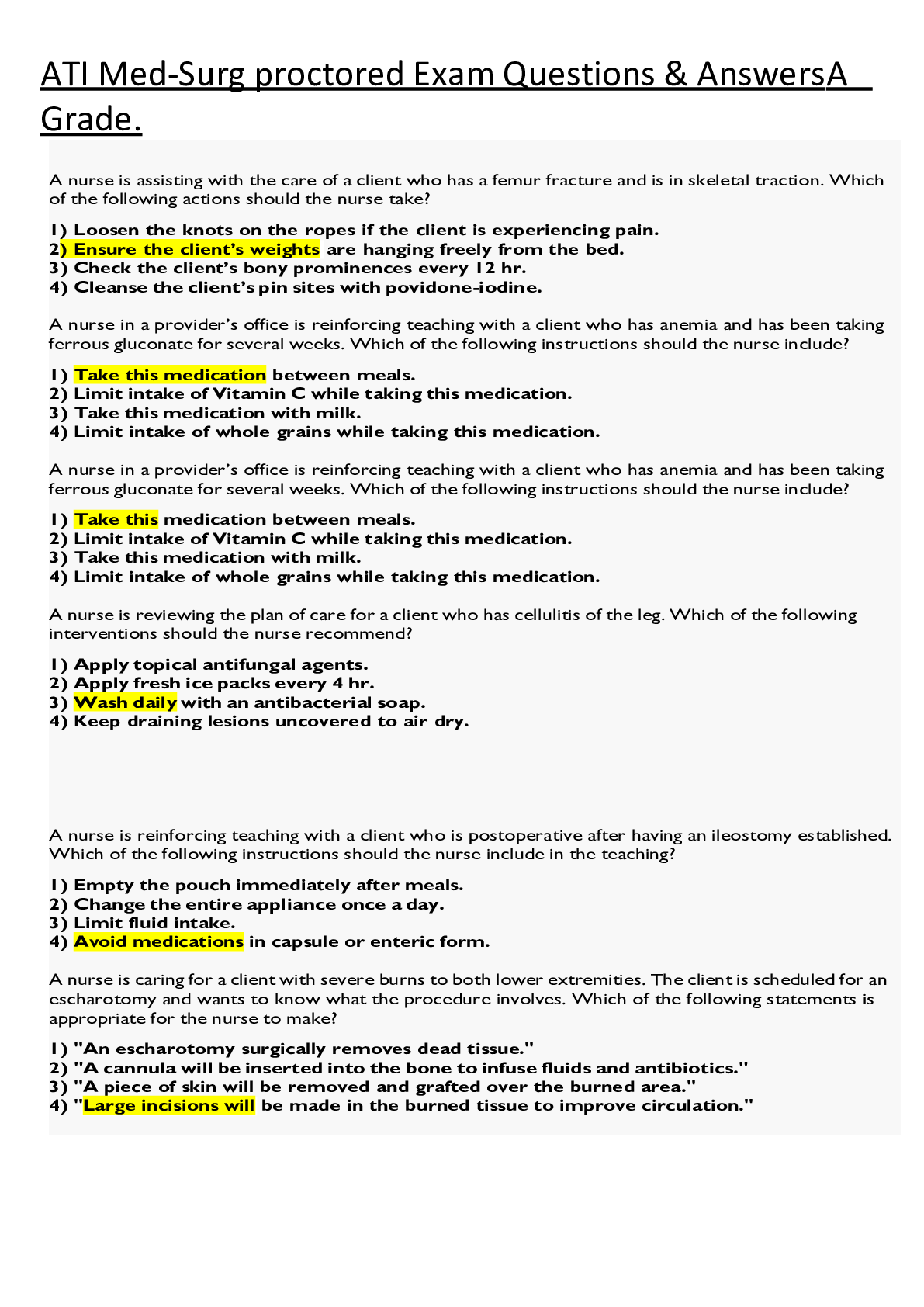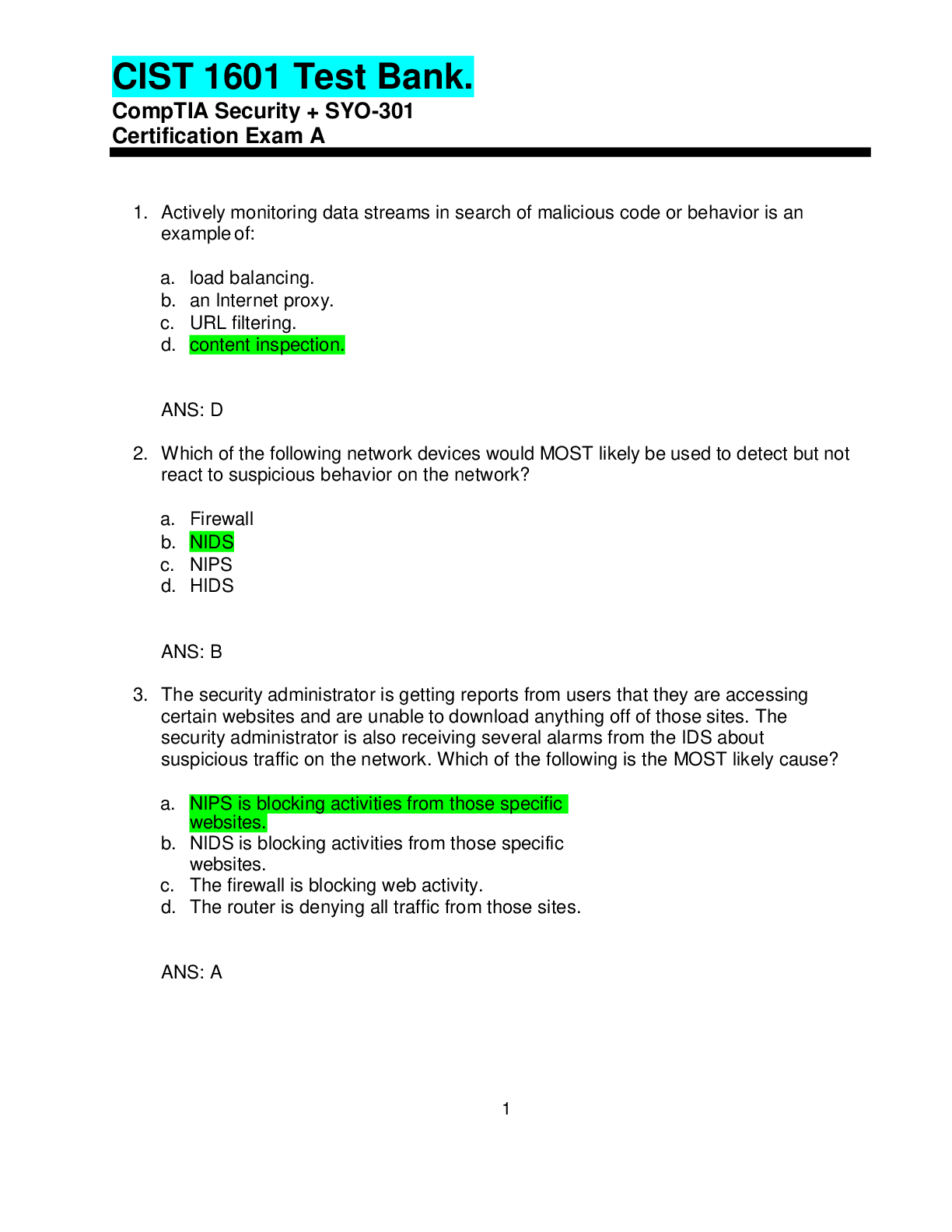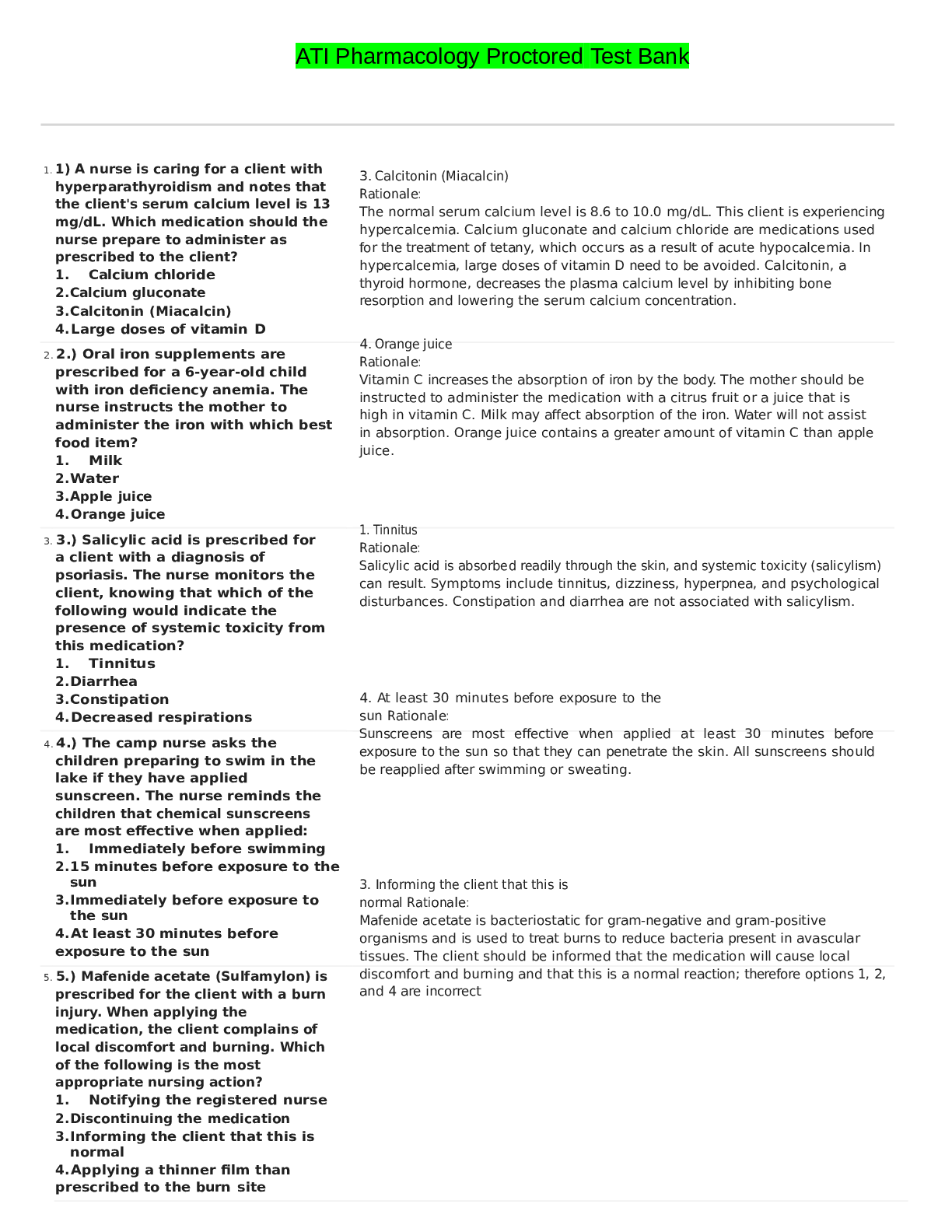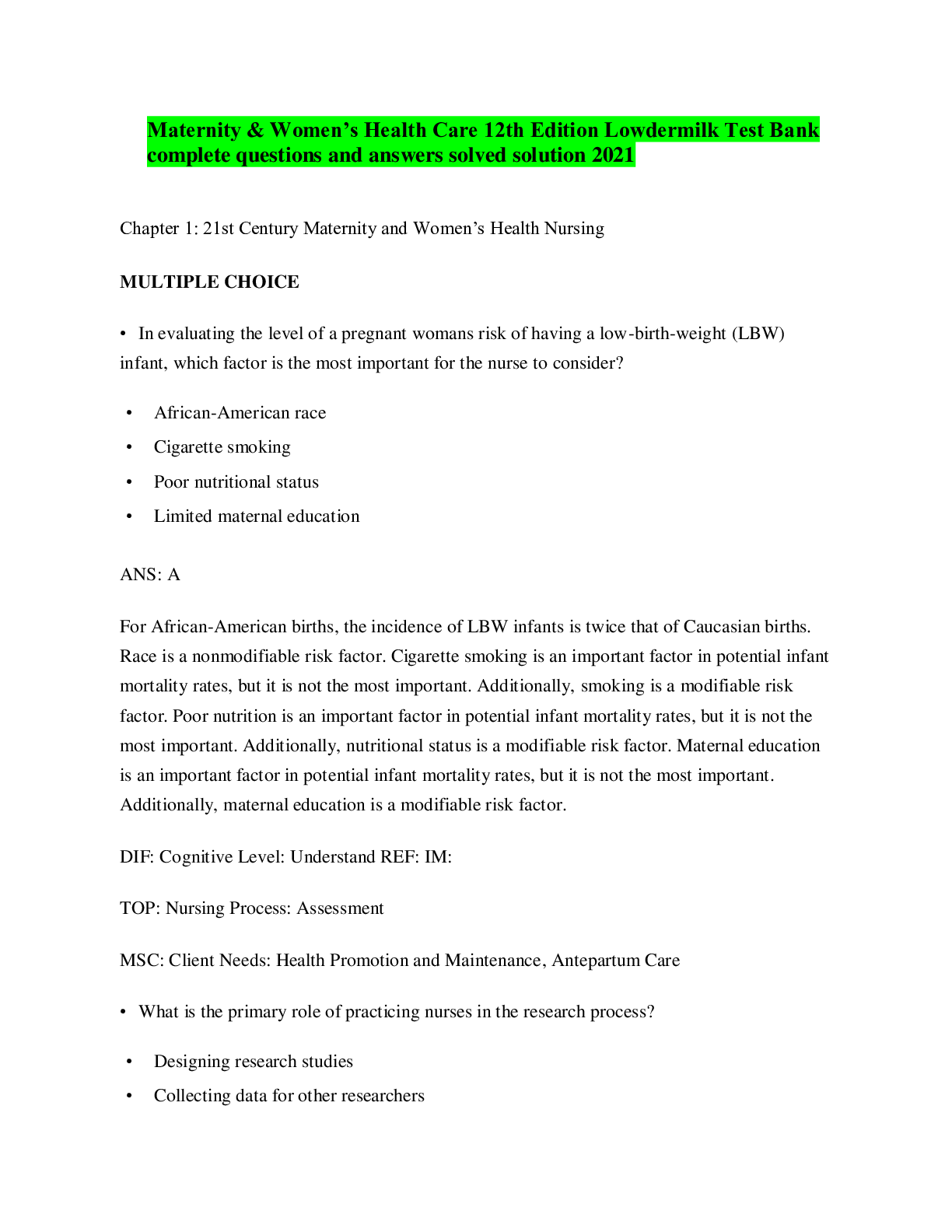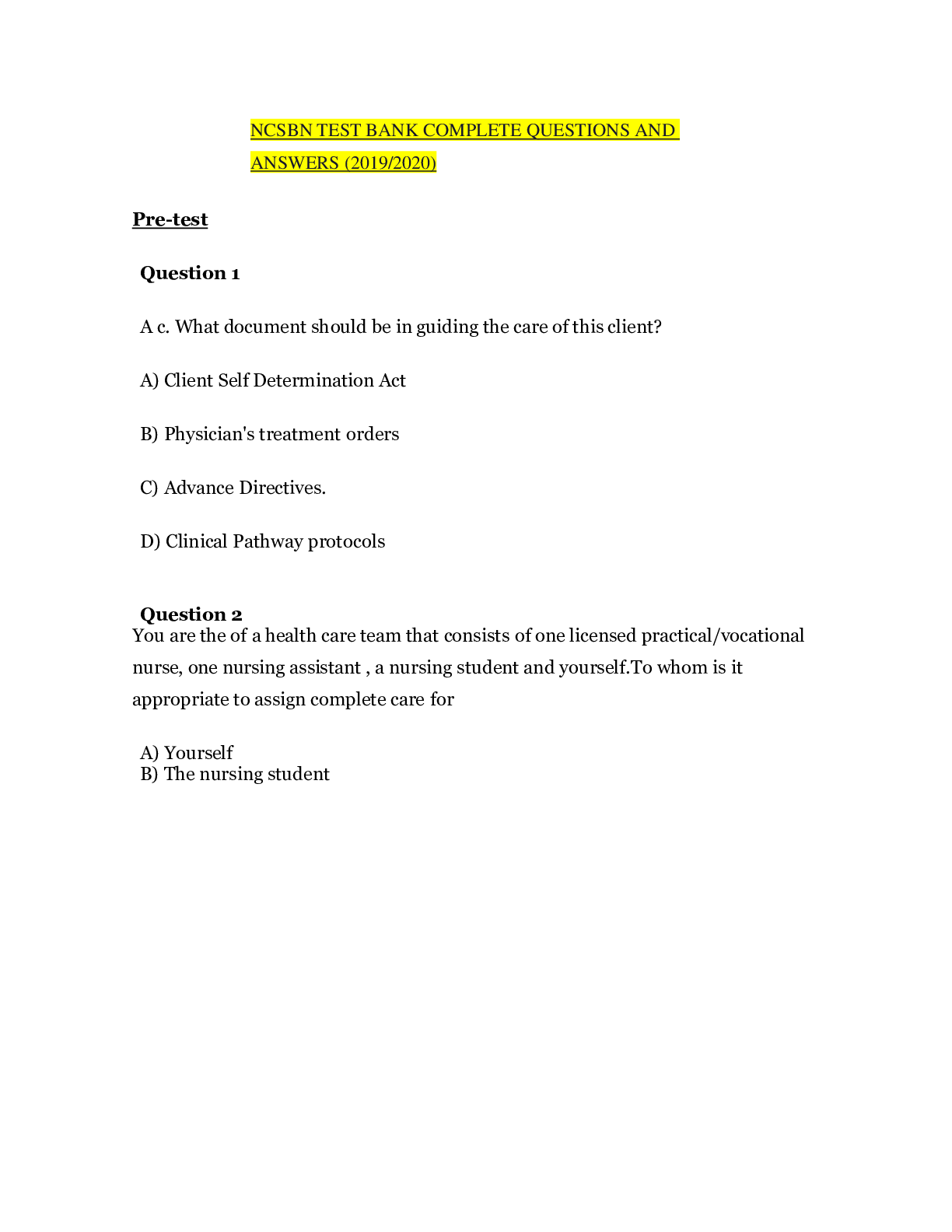Communication > QUESTIONS & ANSWERS > COMS 101 Quiz chapter 11 Test Bank Complete Answers, Latest Guide; Liberty University. (All)
COMS 101 Quiz chapter 11 Test Bank Complete Answers, Latest Guide; Liberty University.
Document Content and Description Below
COMS 101 Quiz chapter 11 Test Bank Complete Answers Question1 ____ is the feeling or evaluation associated with a word. Choose one answer. A. denotation B. demarcation C. connotat... ion D. context Question2 According to scholars, the rules, expectations, and clarity of verbal communication ____. Choose one answer. A. are learned during childhood B. have no effect on the interpretation of meaning C. will vary from culture to culture D. are subject to transformation Question3 The sentiment, "Float like a butterfly, sting like a bee" is an example of a(n) ____. Choose one answer. A. metaphor B. hyperbole C. simile D. exaggeration Question4 If a speaker attempts to evoke the audiences senses-touch, taste, smell, see, hear-then he/she is relying on ____. Choose one answer. A. concrete words B. precise words C. mental pictures D. vivid cues Question5 ____ is a words direct, explicit meaning given by its language community. Choose one answer. A. denotation B. demarcation C. connotation D. context Question6 What is problematic with a speaker begging the audience, "Guys, we can make a difference in the fight against violence is we just organize our resources"? Choose one answer. A. The use of generic language B. The use of vague language C. The suggestion of a problem D. Begging for help Question7 Narrowing a description from "blue collar worker" to "construction worker" to "bulldozer operator" is an example of using ____. Choose one answer. A. concrete words B. precise words C. mental pictures D. vivid cues Question8 While giving an anti-drug speech to a group of middle school students, a speaker attempts to use what she believes is common teen slang. Rather than connecting with the audience, the speaker appears insincere because she didnt consider ____. Choose one answer. A. the formality of the occasion B. the appropriateness of jargon in a speech C. the level of sincerity expected by the audience D. all of the above Question9 "Hear the mellow wedding bells" is an example of a(n) ____ because of the repetition of vowel sounds. Choose one answer. A. alliteration B. assonance C. onomatopoeia D. analogy Question10 While delivering an anecdote about defensive driving, the speaker adds, "Jim is a great driver over the age of 70." What is the speaker doing in this statement? Choose one answer. A. Using hate speech against an elderly driver B. Marking Jim as an elderly driver C. Attempting to create an internal transition D. Using language appropriate for an elderly audience Chapter 11 Question1 Speaking with no changes in pitch, rate or volume is described as speaking ____. Choose one answer. A. with poor articulation B. in a monotone C. impromptu D. conversationally E. in a wrong key Question2 Which of the following is NOT a reason related to the importance of eye contact? Choose one answer. A. Maintaining eye contact helps audiences concentrate on the speech. B. Maintaining eye contact increases the audiences confidence in you, the speaker. C. Maintaining eye contact helps you gain insight into the audiences reaction to the speech. D. All of these Question3 When you practice a speech, you should ____. Choose one answer. A. concentrate on delivery not on content or speech organization B. read from your outline C. say aloud only the main points D. mull over the ideas in your head E. go over it in a situation that is as close as possible to the actual speech Question4 When a person distorts a sound in a word, the problem is called ____. Choose one answer. A. a grammatical mistake B. an articulation error C. an error in pronunciation D. nonfluency E. a phonetic error Question5 A speech that is prepared and practiced, but the exact wording is determined at the time of utterance is one that is ____. Choose one answer. A. impromptu B. memorized C. scripted D. extemporaneous Question6 When a person accents the wrong syllable in a word, the problem is called ____. Choose one answer. A. a grammatical mistake B. an articulation error C. an error in pronunciation D. nonfluency E. a phonetic error Question7 Having eye contact means ____. Choose one answer. A. looking toward the audience throughout the speech B. looking at each person in turn for at least a few seconds C. picking a spot above the heads of the audience and focusing on it D. talking to two or three people in the audience who are paying the most attention Question8 Which of the following is NOT an aspect of nonverbal communication? Choose one answer. A. facial expressions B. gestures C. voice articulation D. all of these Question9 Common articulation problems include ____. Choose one answer. A. emission and reduction B. slurring sounds and leaving off endings of words C. transposition, repetition, and execution D. stuttering and lisping Question10 Articulation refers to ____. Choose one answer. A. using appropriate speaking rate B. the quality of the speaking rate C. shaping the speech sounds into recognizable symbols D. pronunciation Question1 Varying your pitch means ____. Choose one answer. A. talking faster at times, slower at others B. talking louder at times ,softer at others C. talking higher at times, lower at others D. talking sprightly at times, harsh at others E. all of the above Question2 If your boss prompts you unexpectedly to give a quick report on the project that you have been working on at a meeting, you will be giving what type of delivery? Choose one answer. A. extemporaneous B. scripted C. impromptu D. informative E. none of the above Question3 An extemporaneous speech is ____. Choose one answer. A. spoken on the spur of the moment B. written out and then read aloud C. prepared and committed to memory D. prepared and practiced Question4 When a person distorts a sound in a word, the problem is called ____. Choose one answer. A. a grammatical mistake B. an articulation error C. an error in pronunciation D. nonfluency E. a phonetic error Question5 Articulation refers to ____. Choose one answer. A. using appropriate speaking rate B. the quality of the speaking rate C. shaping the speech sounds into recognizable symbols D. pronunciation Question6 Highness or lowness of voice describes the term Choose one answer. A. pitch B. volume C. rate D. quality Question7 Which of the following is NOT a reason related to the importance of eye contact? Choose one answer. A. Maintaining eye contact helps audiences concentrate on the speech. B. Maintaining eye contact increases the audiences confidence in you, the speaker. C. Maintaining eye contact helps you gain insight into the audiences reaction to the speech. D. All of these Question8 A person is said to have a(n) ____ when they have speech habits typical of a certain geographic area. Choose one answer. A. accent B. dialect C. timbre D. none of these Question9 Ordinarily the best notes for your speech will consist of ____. Choose one answer. A. the speech outline your developed in preparation B. complete the sentence statements of main points C. key words or phrases that help trigger your thoughts D. the speech itself written in large letters on note cards Question10 When you practice a speech, you should ____. Choose one answer. A. concentrate on delivery not on content or speech organization B. read from your outline C. say aloud only the main points D. mull over the ideas in your head E. go over it in a situation that is as close as possible to the actual speech Question1 Which of the following is NOT a reason related to the importance of eye contact? Choose one answer. A. Maintaining eye contact helps audiences concentrate on the speech. B. Maintaining eye contact increases the audiences confidence in you, the speaker. C. Maintaining eye contact helps you gain insight into the audiences reaction to the speech. D. All of these Question2 Highness or lowness of voice describes the term Choose one answer. A. pitch B. volume C. rate D. quality Question3 An extemporaneous speech is ____. Choose one answer. A. spoken on the spur of the moment B. written out and then read aloud C. prepared and committed to memory D. prepared and practiced Question4 If your boss prompts you unexpectedly to give a quick report on the project that you have been working on at a meeting, you will be giving what type of delivery? Choose one answer. A. extemporaneous B. scripted C. impromptu D. informative E. none of the above Question5 A moment of silence strategically placed in order to enhance meaning is called a(n) ____. Choose one answer. A. stress B. pause C. gesture D. articulation Question6 When a person distorts a sound in a word, the problem is called ____. Choose one answer. A. a grammatical mistake B. an articulation error C. an error in pronunciation D. nonfluency E. a phonetic error Question7 Speaking with no changes in pitch, rate or volume is described as speaking ____. Choose one answer. A. with poor articulation B. in a monotone C. impromptu D. conversationally E. in a wrong key Question8 When a person accents the wrong syllable in a word, the problem is called ____. Choose one answer. A. a grammatical mistake B. an articulation error C. an error in pronunciation D. nonfluency E. a phonetic error Question9 Having eye contact means ____. Choose one answer. A. looking toward the audience throughout the speech B. looking at each person in turn for at least a few seconds C. picking a spot above the heads of the audience and focusing on it D. talking to two or three people in the audience who are paying the most attention Question10 Which of the following is NOT an aspect of nonverbal communication? Choose one answer. A. facial expressions B. gestures C. voice articulation D. all of these [Show More]
Last updated: 2 years ago
Preview 1 out of 13 pages

Buy this document to get the full access instantly
Instant Download Access after purchase
Buy NowInstant download
We Accept:

Reviews( 0 )
$10.00
Can't find what you want? Try our AI powered Search
Document information
Connected school, study & course
About the document
Uploaded On
Feb 14, 2020
Number of pages
13
Written in
Additional information
This document has been written for:
Uploaded
Feb 14, 2020
Downloads
0
Views
137

